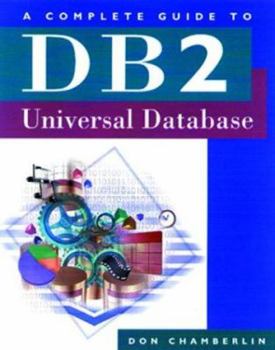A Complete Guide to DB2 Universal Database
Select Format
Select Condition 
Book Overview
DB2 Universal Database (UDB) supports many different types of applications, on many different kinds of data, in many different software and hardware environments. This book provides a complete guide to DB2 UDB Version 5 in all its aspects, including the interfaces that support end users, application developers, and database administrators. It is complementary to the IBM product documentation, providing a clear and informal explanation of how...
Format:Paperback
Language:English
ISBN:1558604820
ISBN13:9781558604827
Release Date:June 1998
Publisher:Morgan Kaufmann Publishers
Length:816 Pages
Weight:3.05 lbs.
Dimensions:1.7" x 7.0" x 10.1"
Customer Reviews
5 ratings
...A carry-on item.
Published by Thriftbooks.com User , 24 years ago
Don's "A Complete Guide..." is both, TOP-SHELF; and a CARRY-ON ITEM (wgth:28.35ozs, 1,347grams). Don and his editorial team have achieved an enjoyable; comprehensive; and succinct treatment of DB2/UDB in a mere 767 pages. More than just a great guide, Don gives us glorious insights into our burgeonning world of multi-Domain Enterprise Servers, --so anyone involved in learning more about the "Open" approach will enjoy it. The Table of Contents reads as a Primary-Menu to the evolving family of DB2 system products and provides very nice gleanings of the emerging SQL3 forward posture.DB2 professionals will likely be packing their own personalized-annotated copies along with their lap-tops and backup tooth brushes.
Excellent book. The only DB2 UDB reference you may ever need
Published by Thriftbooks.com User , 24 years ago
Be it the fundamental SQLs or the major changes to DB2 under the Universal Database umbrella, you can find everything in this book. The time spent on every detailed aspect of this book needs to be appreciated, even the pictures at the beginning of every chapter are so meticulously done. A must for any DB2 UDB professional.
Comprehensive, engaging, essential treatment of DB2 UDB
Published by Thriftbooks.com User , 25 years ago
The idea of a universal database (UDB) was invented as a reaction to object-oriented databases of the early 1990s from Object Store, Gemstone, and Versant. Capabilities were added to the prevailing dominant design of relational database management systems (RDBMs), including user defined functions and data types, enhanced stored procedures and triggers (active database components), and SQL extensions. It is a winning idea and one that has gained "top of mind position" in the market, relating the n-relational competition to niche players. One of the ironies of technology is that you can tell the pioneers by the arrows in their back. In many instances IBM has been first, and has the arrows to prove it. In the instance of UDB this was not the case - the term having been popularized elsewhere - but they have had the opportunity to leap-frog the competition. Don Chamberlin's comprehensive guide to the product - DB2 UDB - is suitable for entry level database developers as well as advanced technicians. It is a pleasure to find such a formidable subject treated in such a readable, professional, and entertaining way without assuming that the audience is in any way intellectually challenged (as, for example, occasionally happens in the dummy series). The opening chapter contains a fascinating brief history of structured query language (SQL) in which the author and his colleague Ray Boyce are deservedly credited with the invention of what has proved to be a powerful and compelling non-procedureal English-like interface to relational databases. Query Power (Chapter Five) starts looking at interesting SQL extensions, include new built in functions of the kind useful in data warehousing (and decision support) applications), rollup, cube and grouping sets. This illustrates a familiar feature of technology innovation and evolution - built in functions that required purchase of separate proprietary products such as Red Brick - are now bundled as part of the UDB product. An especially engaging fact is that the approach to Stored Procedures enabled by IBM makes use of procedural languages - C, C++, a version of Basic, and (note well) Java - as the host code in which the SP's SQL is embedded. This sets a standard for openness, interoperability, and portability, which may make the other database vendors with proprietary scripting languages cringe. A possible outcome: Convergence on Java. It is hard to imagine that in a superbly written book of nearly 800 pages, six useful appendices, an excellent detailed index, supplementary exercises on the Web, anything more could be said. Even the on-going "Webificaiton" of the planet falls within the horizon, since dynamic SQL with Java receives a useful treatment with sample program (pp. 498ff). The nicely edited and prepared text is supplemented with charming illustrations by Duane Bibby of a bird-like creature, which seems to morph between a sea gull and an owl, depe
A must read for anyone using DB2 UDB
Published by Thriftbooks.com User , 25 years ago
Whether you are new to DB2 UDB or an expert, this book is for you. It works as both the perfect learning tool and an excellent reference book that should be on every DB2 UDB user's desk.
A pleasure to read! Very good editing.
Published by Thriftbooks.com User , 25 years ago
It is clear that Don Chamberlin knows the DB2 product. It is also refreshing to read an up-to-date book that isn't full of spelling and grammer errors. This book will get you up and running on DB2 without being a DBA. (There is plenty of time for that later). DB2 UDB graphic interface is a giant step forward for IBM! There is some reference to using DB2 UDB with Java but not very much.




